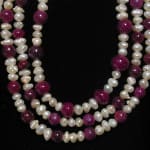Ruby Bead and Freshwater Pearl Necklace
Ruby and Pearl
FJ.5047
Further images
In Matthew, the kingdom of heaven is compared to a single rare and costly pearl for which a man would sell all he has. The delicate, lustrous beauty of the...
In Matthew, the kingdom of heaven is compared to a single rare and costly pearl for which a man would sell all he has. The delicate, lustrous beauty of the pearl has captured the imagination of men and women since the dawn of time. Early cultures worshiped it as a symbol of the moon goddess, a token of perfection. This exquisite gem is formed when an irritant becomes trapped inside the shell of a mollusk, most often an oyster. To protect itself, the animal forms a coating of nacre around the intrusive object, and this eventually may become a pearl. The gem ranges in color from pale white, to rosy pink, to gray or black. In the classical world, the finest pearls came from the Persian Gulf and the Indian Ocean, sometimes traveling for years to reach the palaces of Greece and Rome. Cleopatra, the queen of Egypt, is said to have dissolved an enormous pearl in wine, which she then drank to impress her lover Marc Antony with her extravagance. In the courts of Renaissance Europe, status was often measured through the size and beauty of one's pearls. Over thousands of years, pearls are one of the few jewelry items to remain continuously in fashion. It is easy to see why. They delight the eye and flatter the wearer, a true gift from nature.
Considered in the Ancient East to be the luckiest of all gems, the ruby is said to confer upon its owner protection from all misfortune either manmade or natural. Like the sapphire, the ruby is a member of the corundum family, an aluminum oxide which owes its bright red color to the trace presence of chromium. The major sources for this mineral bath in antiquity and today is the Orient, especially Burma, Thailand and India. On a carat for carat basis, the ruby is generally the most expensive of all precious stones. The most prized hue for the gem is called "pigeon's blood", a deep red touched with violet; a necklace of these stones is said to have been given by Alexander the Great to the Queen Mother of Persia. However, because of its Eastern origins, the ruby was little known to the Classical cultures of the West. In the East, especially India, the ruby was much sought after; Sanskrit writings refer to it as the "king of gems". Its red color associated it medicinally with diseases of the blood, and it was especially valued to ward off pestilence, to staunch bleeding, as well as cure diseases of the stomach. in Eastern belief, it also promoted peace and prosperity for its owner, and granted him invulnerability from all evil.
Considered in the Ancient East to be the luckiest of all gems, the ruby is said to confer upon its owner protection from all misfortune either manmade or natural. Like the sapphire, the ruby is a member of the corundum family, an aluminum oxide which owes its bright red color to the trace presence of chromium. The major sources for this mineral bath in antiquity and today is the Orient, especially Burma, Thailand and India. On a carat for carat basis, the ruby is generally the most expensive of all precious stones. The most prized hue for the gem is called "pigeon's blood", a deep red touched with violet; a necklace of these stones is said to have been given by Alexander the Great to the Queen Mother of Persia. However, because of its Eastern origins, the ruby was little known to the Classical cultures of the West. In the East, especially India, the ruby was much sought after; Sanskrit writings refer to it as the "king of gems". Its red color associated it medicinally with diseases of the blood, and it was especially valued to ward off pestilence, to staunch bleeding, as well as cure diseases of the stomach. in Eastern belief, it also promoted peace and prosperity for its owner, and granted him invulnerability from all evil.







